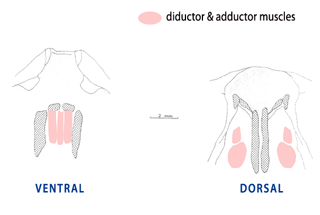 |
|
|||
|
Genus Macandrevia King, 1859 |
| [= Macandrewia Bronn, 1862; Frenula Dall, 1871; = Waldheimiathyris Helmcke, 1939; = Notorygmia Cooper, 1972] [Type species= Terebratula cranium Müller, 1776 (p. 261)] |
Subpentagonal in outline, smooth or with fine radial sculpture, umbo suberect to erect, deltidial plates rudimentary, pedicle foramen possibly permesothyrid, attrite; teeth moderate to large, dental plates short, straight, ventrally divergent, united by callus deposit closely applied to floor of valve; crural bases fused with inner socket ridges, crural plates steeply inclined to floor of valve, extended anteriorly, forming long, V-shaped trough extending about 0.5 valve length, low median ridge present early in ontogeny, but median septum absent in adult, loop extending about 0.75 valve length, smooth except for anterior fringe of short spines, ascending branches and transverse band moderately broad with short, posterior projections at union; diductor muscle scars attached to small, transverse impression over dorsal umbo; endopunctae minute, rather widely separated. |
| Eocene - Present
Diagnosis from volume 5 of the
|
| Extant Species of Macandrevia |
|
| Diagnosis Diagnosis Diagnosis Diagnosis |
|
|

